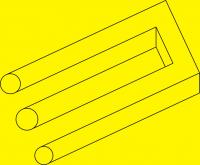Loosing steps running long program
- BigJohnT
-

- Offline
- Administrator
-

Less
More
- Posts: 3990
- Thank you received: 994
13 Jan 2014 21:09 #42700
by BigJohnT
In the stepper world voltage is power!
JT
Replied by BigJohnT on topic Loosing steps running long program
I'm a happy camper!
And a 50V power supply is in the mail. Looking forward to what that one will do. Run 36V now.
Also about to order ballscrews.
Anders
In the stepper world voltage is power!
JT
Please Log in or Create an account to join the conversation.
- awes
- Offline
- Junior Member
-

Less
More
- Posts: 20
- Thank you received: 3
14 Jan 2014 04:05 #42710
by awes
Replied by awes on topic Loosing steps running long program
Question related to my tests.
I tried to read up on steppers and I understand that they are stronger the slower they run, right?
So when I went from 1/4 step to 1/2 step I actually lowered the speed the motor need to run to provide a desired feed-rate (actually half the speed). And by doing that I ended with a motor that is stronger at the desired feed-rate?
Have I got this right?
Anders
I tried to read up on steppers and I understand that they are stronger the slower they run, right?
So when I went from 1/4 step to 1/2 step I actually lowered the speed the motor need to run to provide a desired feed-rate (actually half the speed). And by doing that I ended with a motor that is stronger at the desired feed-rate?
Have I got this right?
Anders
Please Log in or Create an account to join the conversation.
- BigJohnT
-

- Offline
- Administrator
-

Less
More
- Posts: 3990
- Thank you received: 994
14 Jan 2014 08:42 #42738
by BigJohnT
Replied by BigJohnT on topic Loosing steps running long program
There is quite a bit of good info on the wiki site about steppers.
wiki.linuxcnc.org/cgi-bin/wiki.pl?Steppe...or_Speed_Limitations
Steppers are rated with holding torque which is how hard they can stay still and do nothing. Better stepper drives like the Gecko 203v will start at 10 micro steps and morph to single steps as the speed increases for the best torque. Stepper torque is like helicopters everything must balance to work well.
Changing from 1/4 step to 1/2 step only means that it takes 2 steps between each full step. One rev of the stepper is still one rev it just takes 1/2 the step pulses to make one rev. Normally full step means it takes 200 step pulses to move one revolution and 1/2 step means it takes 400 step pulses to move one revolution.
JT
wiki.linuxcnc.org/cgi-bin/wiki.pl?Steppe...or_Speed_Limitations
Steppers are rated with holding torque which is how hard they can stay still and do nothing. Better stepper drives like the Gecko 203v will start at 10 micro steps and morph to single steps as the speed increases for the best torque. Stepper torque is like helicopters everything must balance to work well.
Changing from 1/4 step to 1/2 step only means that it takes 2 steps between each full step. One rev of the stepper is still one rev it just takes 1/2 the step pulses to make one rev. Normally full step means it takes 200 step pulses to move one revolution and 1/2 step means it takes 400 step pulses to move one revolution.
JT
Please Log in or Create an account to join the conversation.
- andypugh
-

- Offline
- Moderator
-

Less
More
- Posts: 19757
- Thank you received: 4588
15 Jan 2014 00:56 #42774
by andypugh
When LinuxCNC makes a backlash-compensation move it does it at maximum acceleration and speed. It is possible that your acceleration is set higher than the physical system can manage.
Replied by andypugh on topic Loosing steps running long program
should have mentioned. I do have a backlash on the machine that I use linuxcnc to compensate for.
When LinuxCNC makes a backlash-compensation move it does it at maximum acceleration and speed. It is possible that your acceleration is set higher than the physical system can manage.
Please Log in or Create an account to join the conversation.
- awes
- Offline
- Junior Member
-

Less
More
- Posts: 20
- Thank you received: 3
12 Feb 2014 01:06 #43764
by awes
Replied by awes on topic Loosing steps running long program
Picking up this topic again.
Reading the link about stepper motor limitations (thanks for the link) say (if i understand it right) that microstepping will reduce torque radically.
But reading this paper they claim that 64x microstepping will give about the same torque as full step.
www.linengineering.com/contents/stepmoto...tep_Motor_Basics.pdf
But for me, with what looks to be a torque challenge, I assume it would be best to run at half step. Or should I try 64?
Reading the link about stepper motor limitations (thanks for the link) say (if i understand it right) that microstepping will reduce torque radically.
But reading this paper they claim that 64x microstepping will give about the same torque as full step.
www.linengineering.com/contents/stepmoto...tep_Motor_Basics.pdf
But for me, with what looks to be a torque challenge, I assume it would be best to run at half step. Or should I try 64?
Please Log in or Create an account to join the conversation.
- PCW
-

- Offline
- Moderator
-

Less
More
- Posts: 17538
- Thank you received: 5126
12 Feb 2014 01:44 #43770
by PCW
Replied by PCW on topic Loosing steps running long program
Microstepping does _not_ reduce available torque significantly
The torque _per microstep_ is what is reduced.
This just means that microstepping will not significantly
improve your precision, just smoothness.
The disadvantage of high ustep ratios is that your computer
has to generate a faster step rate to go the same speed.
This is not an issue with hardware step generation but if you
are running the step drive from a PC parallel port, a ustep ratio of 64
will likely reduce you maximum possible speed considerably.
The torque _per microstep_ is what is reduced.
This just means that microstepping will not significantly
improve your precision, just smoothness.
The disadvantage of high ustep ratios is that your computer
has to generate a faster step rate to go the same speed.
This is not an issue with hardware step generation but if you
are running the step drive from a PC parallel port, a ustep ratio of 64
will likely reduce you maximum possible speed considerably.
Please Log in or Create an account to join the conversation.
- awes
- Offline
- Junior Member
-

Less
More
- Posts: 20
- Thank you received: 3
12 Feb 2014 02:08 #43772
by awes
Replied by awes on topic Loosing steps running long program
Aha, thanks for the clarification.
And the link I found state that when I reread it (5-10% in torque loss only)
Now comes an additional question which I think is related.
Direct drive or not?
I have seen impressing feedrates with fairly small steppers with direct drive on ytube . But almost all retro fit kits comes with pulleys for 3:1 or similar...
And the link I found state that when I reread it (5-10% in torque loss only)
Now comes an additional question which I think is related.
Direct drive or not?
I have seen impressing feedrates with fairly small steppers with direct drive on ytube . But almost all retro fit kits comes with pulleys for 3:1 or similar...
Please Log in or Create an account to join the conversation.
- Rick G
-

- Offline
- Junior Member
-

Less
More
- Posts: 27
- Thank you received: 114
12 Feb 2014 17:17 #43798
by Rick G
Replied by Rick G on topic Loosing steps running long program
Direct drive for a stepper system has the advantage of higher potential speed, if the motors are strong enough.
A 3:1 ratio gives higher torque so higher acceleration is possible and of course higher holding power, better resolution.
Another factor is most stepper motors have a low speed vibration, at a narrow slow rpm range the vibration is considerably worse then at higher speeds, your cuts may be smoother if you avoid cutting in this range.
Rick G
A 3:1 ratio gives higher torque so higher acceleration is possible and of course higher holding power, better resolution.
Another factor is most stepper motors have a low speed vibration, at a narrow slow rpm range the vibration is considerably worse then at higher speeds, your cuts may be smoother if you avoid cutting in this range.
Rick G
Please Log in or Create an account to join the conversation.
- awes
- Offline
- Junior Member
-

Less
More
- Posts: 20
- Thank you received: 3
11 Mar 2014 19:31 #44665
by awes
Replied by awes on topic Loosing steps running long program
I done some testing now and this is what I found.
First, my motors are not optimal. Not well matched with drivers and voltage regulator. Too high inductance.
I got it as a "package" from Wantai motors, but obviously not a well composed package.
I have also changed to ballscrews.
* On one of the axis I was jumping between 3:1 and direct drive back and forth a couple of times and got consistent better performance with direct drive. (higher speed and higher acceleration without stalling)
I jog at around 1650mm/min and pretty high acceleration without stalling.
* I also tested microstepping and when going from 2 to 4 (or 8) motors stalled at VERY low speed and acceleration. So VERY much weaker.
Still not got my new voltage regulator (problem with shipping) so still not sure what I will be able to get out of my current setup without changing more components (e.g. motors that are better match to my drivers and available voltage regulator).
Still more test needed. So many permutations to test.....
First, my motors are not optimal. Not well matched with drivers and voltage regulator. Too high inductance.
I got it as a "package" from Wantai motors, but obviously not a well composed package.
I have also changed to ballscrews.
* On one of the axis I was jumping between 3:1 and direct drive back and forth a couple of times and got consistent better performance with direct drive. (higher speed and higher acceleration without stalling)
I jog at around 1650mm/min and pretty high acceleration without stalling.
* I also tested microstepping and when going from 2 to 4 (or 8) motors stalled at VERY low speed and acceleration. So VERY much weaker.
Still not got my new voltage regulator (problem with shipping) so still not sure what I will be able to get out of my current setup without changing more components (e.g. motors that are better match to my drivers and available voltage regulator).
Still more test needed. So many permutations to test.....
Please Log in or Create an account to join the conversation.
- allenwg2005
-

- Offline
- Elite Member
-

Less
More
- Posts: 224
- Thank you received: 4
30 Mar 2019 16:13 #129973
by allenwg2005
Replied by allenwg2005 on topic Loosing steps running long program
awes,
What did you learn in the end on this??
What did you learn in the end on this??
Please Log in or Create an account to join the conversation.
Moderators: piasdom
Time to create page: 0.110 seconds
